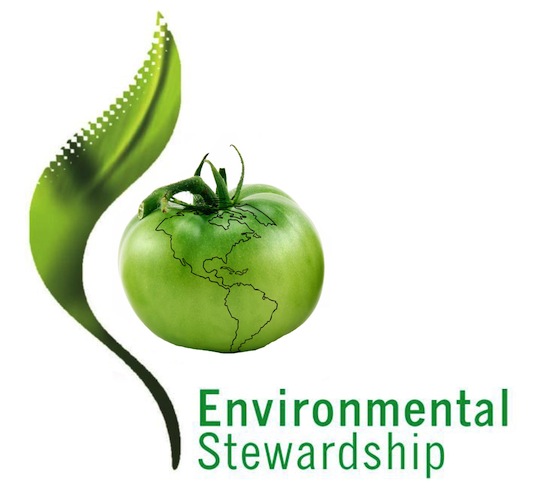Environmental Stewardship
The Environmental Stewardship Work Area helps us become responsible stewards of God's creation, and care for humankind. We
- Provide environmental education
- Encourage individual and corporate green living habits
- Help the church take steps to make our facilities more energy efficient and earth friendly
- Provide avenues for environmental social action
Advantages for Purchasing Local Produce Year Round
 Various local produce is alive and well and available during a large portion of the year here in Illinois. Most of the local produce that is available in one given month is typically available for a period of three to four months following. For example, local produce that is available in April is also available in May and June, and so forth. There are many advantages for purchasing local produce, such as: (a) Local produce tastes better (b) Local produce retains its nutrients longer (c) Local food preserves genetic diversity (d) Local farmers don’t have access to genetically modified seed (e) Local food provides support to local farm families (f) Local food builds community (g) Local food preserves open farm space (h) Our taxes are kept in check, since farms contribute more in taxes than they require in services (i) Local food supports a clean environment and benefits wildlife (j) Buying local food today ensures that there will be community farms tomorrow.
Various local produce is alive and well and available during a large portion of the year here in Illinois. Most of the local produce that is available in one given month is typically available for a period of three to four months following. For example, local produce that is available in April is also available in May and June, and so forth. There are many advantages for purchasing local produce, such as: (a) Local produce tastes better (b) Local produce retains its nutrients longer (c) Local food preserves genetic diversity (d) Local farmers don’t have access to genetically modified seed (e) Local food provides support to local farm families (f) Local food builds community (g) Local food preserves open farm space (h) Our taxes are kept in check, since farms contribute more in taxes than they require in services (i) Local food supports a clean environment and benefits wildlife (j) Buying local food today ensures that there will be community farms tomorrow.
- Log in to post comments
The Green Tomato and the "American Diet"
The typical American diet is high in refined grains, added sugars and fat. This has contributed to an increased risk of chronic illnesses such as cardiovascular disease and Type 2 diabetes.
Meat and poultry are major sources of saturated fat, which raises cholesterol levels and increases the risk of heart disease. The fat increases the buildup of plaque in veins, which stresses the heart as it has to work harder to circulate blood. When eventually blood cannot flow through damaged veins, bypass surgery is needed to bypass those veins.
Sweets and soda have become two of the top five sources of calories in the American diet. Decreasing the intake of these two foods, along with exercise, can help individuals maintain healthier weights.
Convenience has also contributed to a decline in our diets. The rise of two-income families has led to increased use of convenience foods and to eating out, both of which have increased calorie intake and expanded waistlines.
Studies in Japan and the United States have shown that while 30% of U.S. women may get breast cancer, only 1% of Japanese women suffer from this disease. Researchers concluded that a high-fiber, plant-based diet in Japan is the reason, plus the Japanese eat more fish than Americans.
As a result, diets that include fruits, vegetables, whole grains and varying sources of lean proteins can better control weight and reduce the risk of chronic illness.
- Log in to post comments
Why You Should Buy Local Food
Healthier
Food grown locally was probably picked within the last day or two. It’s crisp, sweet and loaded with flavor. Locally grown food, purchased soon after harvest, retains its nutrients. Local food is not genetically modified food. Local farmers do not have access to genetically modified seed, and most farmers would not use genetically modified seed if they could. You can feel good knowing when you buy local food it is produced the old fashioned way as nature intended.
Helps Your Neighbor
Fewer than one million Americans now say farming is their primary occupation. The reason why is because commodity prices are at historic lows, often below production costs. Farmers now get less than 10 cents of the retail food dollar. When consumers buy direct from local farmers, this cuts out the middleman and farmers get full retail price for their food, which means farm families can afford to stay on the farm, doing the work they love.
Builds Your Community
Buying direct from the farmer, you help preserve time honored connection between the eater and the grower. Knowing the farmer educates you on the seasons, the weather, and the miracle of raising food. You can also gain access to a farm where your children and grandchildren can learn about nature and agriculture. You are also helping preserve open space because when you buy locally grown food, selling farmland for development becomes less likely. Buying local food helps keep your taxes in check, because farms contribute more in taxes than they require in services, whereas urban development cost more than it generates in taxes. When you buy local food you help support a clean environment, because a well-managed farm is a place where natural resources such as fertile soil and clean water are valued. Farmers who practice good conservation tillage could sequester 12 – 14% of the carbon emitted by vehicles and industry.
Long-Term Benefits
When you support local farmers, you are helping to see that there will be farms in your community for years to come, producing nutritious, flavorful, and abundant food.
- Log in to post comments
Exploring our Relationship to Meat in an Informed Era
 For most of us I expect, our relationship to meat and its relationship to us was fairly elemental growing up in the Midwest. Farmers raised it, and we ate it. We weren’t likely to ask probing questions such as what the livestock ate, what the conditions were on the farms they inhabited, or how they were slaughtered. We certainly weren’t interested in the water, energy and other resources that were required to sustain these livestock. In fact, even with the publication of Rachel Carson’s Silent Spring in 1962, and the associated mounting pressure to develop a higher consciousness around the widespread application of toxic herbicides and insecticides such as DDT, most of us didn’t make – or maybe didn’t want to make – the systemic connection between poisoning the land and its creatures and poisoning ourselves.
For most of us I expect, our relationship to meat and its relationship to us was fairly elemental growing up in the Midwest. Farmers raised it, and we ate it. We weren’t likely to ask probing questions such as what the livestock ate, what the conditions were on the farms they inhabited, or how they were slaughtered. We certainly weren’t interested in the water, energy and other resources that were required to sustain these livestock. In fact, even with the publication of Rachel Carson’s Silent Spring in 1962, and the associated mounting pressure to develop a higher consciousness around the widespread application of toxic herbicides and insecticides such as DDT, most of us didn’t make – or maybe didn’t want to make – the systemic connection between poisoning the land and its creatures and poisoning ourselves.
Growing Awareness of Connection Between Us and “Livestock”
This clear connection between poisoning our food sources and poisoning ourselves seems elemental in hindsight of course, but the 60s and 70s were a window of great tumult in the country, and it seemed that many of the strongest voices of protest were being spent on pressuring our leaders to withdraw from the Vietnam War, or to address the persistent racial/cultural and gender divides that plagued the nation, and many would say, plague it to this day. Perhaps we had too many societal challenges to canvas to have given our food supply and our shifting relationship to its production and consumption the attention it deserved.
While the history of organic farming practice dates to the 1930s, it exploded in the 1990s and continues unabated today. The organic meat movement might arguably be linked to the discovery of Bovine Spongiform Encephalopathy (BSE) or, as it became more commonly known – Mad Cow Disease. The first confirmed case in the US was in late 1993. This frightening disease attacks the brain and spinal cord of the infected animal. Consuming meat from an infected animal can cause serious illness or death. Millions of cattle in Britain have been destroyed to prevent the spread of the disease to humans. Its emergence has provoked a growing global dialogue on the safety of meat and meat by-products, not limited to this disease, but encompassing the complex system of bringing meat to market.
Other influences have driven more farmers to consider establishing more organic practices, including social consciousness of the treatment of animals, a connection between lean meat protein and better health, and shifting lifestyles.
What is Organic Meat?
One of the great ruses of this rise in interest in healthier eating has been the seemingly endless references to “natural” foods. Whether in advertising or on labels, for years we have been assaulted with claims of natural, naturally derived, low-fat or fat-free foods from every corner of the supermarket, radio and television. Many of us now cast a critical eye towards these claims, and are more vigilant in reading labels and not being taken in by overzealous advertising. Much of this knowledge has been driven by consumer advocacy organizations pressing the FDA to require more accurate, digestible and honest labeling and claims associated with many of these “healthy” foods.
I think that we are beginning to sort out the discussion on organics – and organic meats – in a similar manner. The agricultural producers, and markets, are starting to recognize that consumers are asking critical questions about the meaning of organic and its relationship to other challenging issues in our food ecosystem such as genetically modified organisms (GMOs), transportation and energy costs to produce and get foods to the consumer vs. locally-raised and distributed foods, trade practices of the producers, and the link between humane treatment and slaughter of animals raised for consumption and our own health.
There are now clearing, if not crystal clear, defining elements for meat to be considered organic. Foremost among these are their living environment, lack of hormones or antibiotics, healthy feed source, clean water source, sustainable practices, etc. The US Department of Agriculture has clear standards in place dictating what meats can be noted as organic. These standards, along with those for other organic foods, are explained in its National Organic Program. However, once a farm or producer has been certified as organic, oversight has been problematic. As of 2013, new oversight standards were implemented through the Agricultural Marketing Service (AMS) of the US Department of Agriculture.
Like any costly process linked to a multi-billion dollar industry, there will be producers looking to sidestep requirements when not scrutinized, so we all benefit by our vigilance and awareness of the standards. Ask questions of your local grocer, push for more organic meat choices and consider supporting those stores that are open and educating about their organic meat choices. For example, Whole Foods Markets meats are USDA certified organic but also adhere to the Global Animal Partnership Animal Welfare Rating System. In practice, I think that consuming more locally produced organic meats, fruits and vegetables when possible is a great way to get closer to the issues and gain a more realistic understanding of our intimate relationship to the foods and meats we consume.
- Log in to post comments
Christmas Light Recycling
 Don't throw away your tangled, frayed or burned-out Christmas lights this year! This holiday season, the Village of Downers Grove is offering recycling of Christmas tree lights and extension cords.
Don't throw away your tangled, frayed or burned-out Christmas lights this year! This holiday season, the Village of Downers Grove is offering recycling of Christmas tree lights and extension cords.
A receptacle is available at the Public Works Facility, 5101 Walnut Ave through February 1, 2014. Items may be dropped off, Monday through Friday, 8:00 a.m. to 5:00 p.m. Acceptable items are: Mini-lights (also known as Italian lights); C7 lights; C9 lights; Rope lights; LED lights; and Extension cords.
Visit the Village of Downers Grove website for more details.
- Log in to post comments
'The Story of Timmy Tomato' by Tommy Turnip
 Timmy (The name means one who honors God) traces his genealogy back to the Andes Mountains of Peru, South America. Timmy’s ancestors’ last name was originally Tomatl, which meant round and plump to the Aztecs. In the 16th Century, Spanish conquistadores took the tomatoes back to Europe with them. In the 18th Century, tomatoes were brought to Quebec and Louisiana by the French. Now the tomato is the most widely grown fruit (Yes, technically Timmy is a fruit.) in the Americas.
Timmy (The name means one who honors God) traces his genealogy back to the Andes Mountains of Peru, South America. Timmy’s ancestors’ last name was originally Tomatl, which meant round and plump to the Aztecs. In the 16th Century, Spanish conquistadores took the tomatoes back to Europe with them. In the 18th Century, tomatoes were brought to Quebec and Louisiana by the French. Now the tomato is the most widely grown fruit (Yes, technically Timmy is a fruit.) in the Americas.
Timmy and his relatives suffer and die if the weather is too cold. For Timmy to fulfill his career objective of being a food relished by others and eaten as part of the earth’s ecosystem, he must be grown in a warm climate. Some of Timmy’s second cousins are grown in local greenhouses, and spend much more of their life in the warm confines of their home than on the road. However, Timmy, a Better Boy tomato, was conceived in California and transported to Chicago to fulfill his career objective. In fact, 40% of the world’s tomatoes are grown in California. At first, Timmy thought travel would be great. Then Timmy learned that to prepare for the trip he would have to be washed in chlorinated water, then dried with blasts of warm air and covered with wax. Timmy also learned about the large negative environmental impact this travel has on the earth and he became sad and no longer ripe for use. In particular, long-distance transportation of many of his Tomato family is contributing greatly to greenhouse gas emissions, air acidification, and smog. For example, global warming pollution for food transported by airplane is 500 times greater than pollution from transportation of locally grown foods!
The solution, Timmy does not want to travel; he wants to be close to home, thirsting for a local greenhouse for his offspring and for all future relatives, so they can spend more time on the vine and less time on the road. Some sources say that on average, produce arriving at some Chicago food markets is transported more than 1,500 miles. Yes, sometimes economy of scale can be more efficient, but for most produce, if you want to lessen your negative environmental impact on the earth and preserve the earth for your future family, eat locally grown produce. To see what is in season in our state, or other states, you can visit the Eat Local website.
By the way, in case you were wondering, my friend Timmy Tomato, asked me, Tommy Turnip, to emerge from underground and share the roots of his story. Timmy, who by his very name wants to honor God, knows that we can all make a difference on the planet, one tomato at a time.
- Log in to post comments
The Green Tomato
If you are what you eat, then how is the earth related to what we grow
and what we consume?
 As Christians, we are all charged with the responsibility to care for our planet. This 2013-14 church year the Environmental Stewardship Work Area has chosen as its theme "The Green Tomato." Why did we choose this topic? We all wanted to better understand the interrelationships among how we eat and environmental stewardship. Perhaps there are things that we can do that will benefit both ourselves and the planet.
As Christians, we are all charged with the responsibility to care for our planet. This 2013-14 church year the Environmental Stewardship Work Area has chosen as its theme "The Green Tomato." Why did we choose this topic? We all wanted to better understand the interrelationships among how we eat and environmental stewardship. Perhaps there are things that we can do that will benefit both ourselves and the planet.
Specifically, as our overall population continues to live longer, we all are aware of the need to eat more healthily throughout our lives. We also are aware that we must be responsible care-takers of the Earth. We will be looking at the effect food production has on our Earth’s environment and the implications environmental stewardship has on how and what we eat. Some of the topics we will examine are:
- the benefits of locally grown food/produce
- how meat production and use impacts the environment
- how herbs can be used with health and environmental benefits
- the health aspects of food as it may pertain to Type II diabetes, valve replacements, cholesterol, plaque and cancer
- the benefits of organic food for children, and what sustainability means with respect to food and the environment.
We hope you are also eager to find out more about "The Green Tomato." Bon appétit avec la responsabilité!
- Log in to post comments
Using Fewer Paper Towels Can Make a Difference
 Check out this informative video:
Check out this informative video:
- Log in to post comments
Pages
Recent News
Sunday Worship Service - July 30 at 10:00 am
July 30, 2023 - 9:51am
Sunday Worship Service - July 23 at 10:00 am
July 23, 2023 - 9:48am
Sunday Worship Service - July 16 at 10:00 am
July 16, 2023 - 10:17am
Vacation Bible School
July 14, 2023 - 10:10pm
Sunday Worship Service - July 9 at 10:00 am
July 9, 2023 - 9:53am





